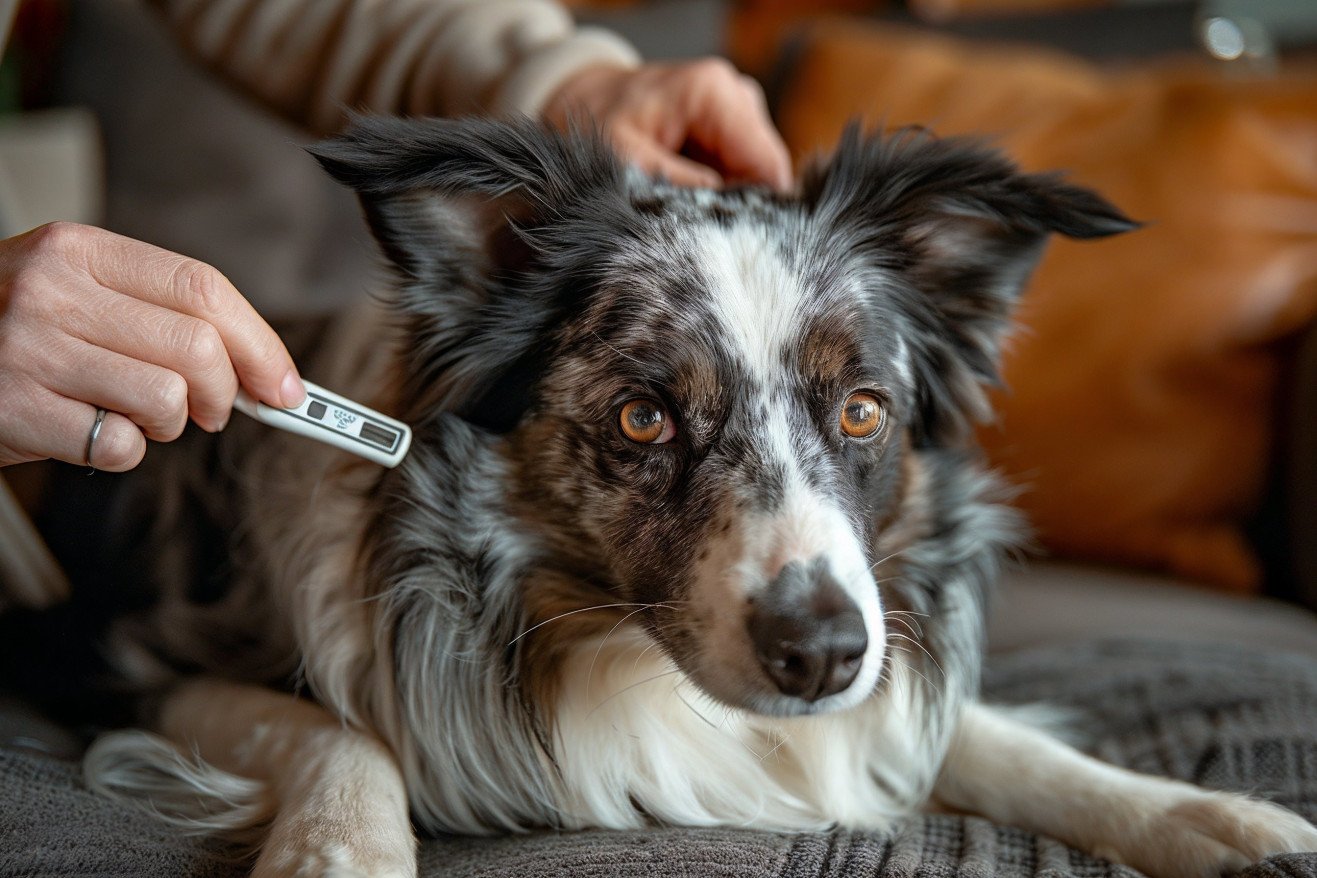Can Dogs Get the Flu from Humans? Interspecies Transmission Risks Explained
10 March 2024 • Updated 9 March 2024

With flu season on the horizon, many dog parents are wondering about the risks of their dogs getting the flu from them. While dogs cannot get the flu from humans, it’s not because of the flu virus itself. The flu virus that affects humans and the flu virus that affects dogs are different strains.
On the other hand, the Canine Influenza Virus, which is the flu that affects dogs, is not known to be transmissible to humans.
In this article, we will delve into veterinary perspectives, epidemiological evidence, and immunological studies to understand the complexities of interspecies disease transmission. This will include an examination of the structure and function of human and canine influenza viruses, the impact of species-specific immune responses, and the history of interspecies viral transmission. By the end of this article, you will have a complete picture of the risks of human-to-dog flu transmission.
Can dogs get the flu from humans?
Where Did Canine Influenza Virus Come From and What Are Its Effects?
Canine Influenza Virus (CIV) is caused by two different strains: H3N8 and H3N2, and each has a different origin. The H3N8 strain jumped from horses to dogs and had been infecting horses for over 40 years before it was first found in dogs in the United States in 2004.
The H3N2 strain, meanwhile, came from birds and was first found in dogs in Asia before arriving in the United States in 2015. Both strains are now considered endemic in the U.S. dog population.
The CDC notes that signs of CIV in dogs can include cough, runny nose, fever, lethargy, eye discharge, and reduced appetite, and can range from mild to severe.
CIV is primarily spread through respiratory secretions from coughing and sneezing dogs, as well as through contact with contaminated objects. In turn, veterinarians and public health officials have created testing guidelines, vaccines, and supportive care options to help control the spread of CIV. The CDC is also working to keep tabs on the situation, evaluate the potential for a pandemic, and make sure that people are safe from zoonotic diseases.
Breaking Down the Differences: Human vs. Canine Influenza
While human and canine influenza viruses are part of the same family, they have genetic and structural differences that have led to their divergence. According to a review in Nature Reviews Microbiology, these differences are important for maintaining species barriers.
Human influenza viruses have evolved to bind to certain sialic acids that are found in the human respiratory tract, while avian and canine influenza viruses have their own mutations that allow them to bind to different host receptors.
Host specificity is determined by specific proteins and genomic segments. For example, the hemagglutinin (HA) surface proteins are responsible for binding and entry into cells, and different influenza strains have different HA proteins that determine their host specificity.
A paper in PMC showed that canine influenza virus (CIV) strains of avian origin were found in dogs in South Korea with clinical signs and histopathological evidence of severe respiratory disease, which shows that these viruses have adapted to their hosts.
There is little evidence to suggest that influenza can be transmitted between humans and dogs. While it is true that the canine respiratory tract has receptors that can bind to avian influenza viruses, as shown by the South Korean study, this does not mean that there is a risk of transmission to humans.
While dogs could potentially act as ‘mixing vessels’ for new influenza strains, there is no evidence to suggest that these strains would be able to infect humans. This informs how we monitor and manage the evolution of influenza, taking into account the hurdles that need to be overcome for viruses to jump between species.
Host Barriers to Influenza Interspecies Transmission
The influenza virus is subject to a number of natural constraints that limit its ability to jump between species. One of the most important of these, as outlined in a paper from PubMed by Thijs Kuiken, is the host species barriers that limit infections. These barriers are made up of physical, cellular, and molecular elements that are highly specialized to a specific species.
Influenza viruses have to overcome a number of evolutionary obstacles to be able to establish themselves in a new host. Viral evolution is a key driver of these interspecies events, especially through mutations that impact virus-host interactions. However, it takes a large number of mutations for a virus to adapt to a new host, which makes interspecies transmission relatively rare.
Molecular changes, including mutations in the surface glycoproteins hemagglutinin (HA) and neuraminidase (NA), can sometimes be so drastic that they create a barrier that the virus can cross.
A study from PMC by Josanne H. Verhagen shows that the receptors on the surface of host cells, including sialic acids with specific linkages, are critical in determining whether a host is susceptible to a particular strain of influenza.
These receptors can vary widely between species, like humans and dogs, which limits the virus to a smaller number of potential hosts and prevents widespread interspecies transmission. This knowledge of the biological factors that limit interspecies transmission can help us understand the evolutionary history of immune systems and how they might interact with influenza.
Understanding How Dogs’ Immune Systems Respond to the Flu
The canine immune system undergoes substantial development from early gestation to late life, as described in PMC. This developmental trajectory is important in determining how dogs’ immune systems will respond to pathogens, including the flu.
The canine and human immune systems are both highly complex and involve a variety of cells and processes that work together to fight off infections, but there are also important differences between the two. According to PubMed, the development of the canine immune system is highly similar to that of humans, with both dogs and humans having fully developed immune systems before birth.
Differences in immune response, especially in adaptive immunity involving T cells and B cells, may impact dogs’ susceptibility to respiratory viruses like the flu. A direct comparison of canine and human immune responses, as outlined in Scientific Reports, shows that while there are many similarities in the major immune pathways, there are also important differences. These differences could be critical in determining whether dogs can fight off flu strains that are transmissible to humans.
Transcriptomic and functional analyses are being used to investigate these differences in the immune responses of dogs and humans and their impact on the transmission of diseases. This research is important because it will help us better understand how to protect the health of our canine friends and prevent the emergence of new flu strains.
Protecting Pets and People: How to Prevent the Spread of the Flu Between Species
There are several ways that dog owners can help prevent the spread of the flu between humans and dogs. One of the most important is to make sure that your pet is vaccinated. The Centers for Disease Control and Prevention recommends that people get vaccinated against the flu and that they also get their dogs vaccinated. This can help protect against the spread of species-specific strains of the virus.
Practicing good hygiene is also important. People can help prevent the spread of the flu to their pets by washing their hands and cleaning surfaces regularly. If your dog is sick and has symptoms like coughing or a runny nose, it’s important to keep them away from other animals and to contact your veterinarian.
It’s also important to make sure that you’re actively looking for new strains of the flu. The World Health Organization’s Global Influenza Surveillance and Response System emphasizes the importance of keeping an eye out for new strains of the flu, including zoonotic influenza viruses.
If your dog has symptoms of a respiratory infection, such as a cough that lasts for more than a few days or lethargy, it’s important to get them to a veterinarian. Not only will this help ensure that your pet gets the care they need, but it will also help contribute to the surveillance system that protects public health.
Canine vs. Human Influenza: A Review
The health of our pets is inextricably linked to our own, and it’s important to understand the nuances of diseases like influenza. Our investigation has shown that dogs can’t get the flu from humans because of the genetic and structural differences between human and canine influenza viruses. While the two viruses are part of the same family, their genetic and structural differences make them species-specific pathogens.
It’s important to know what these species-specific barriers are to protect both pet and public health. The molecular mechanisms that make up host species barriers, along with the unique characteristics of the canine immune system, make potential cross-species infections highly complex.
The importance of ongoing research and surveillance in this area can’t be overstated. By continuing to monitor flu viruses and how they’re evolving, we can best protect ourselves from future pandemics.
This monitoring will help us take a proactive approach to new strains, which will help protect both our dogs and our human population. A deeper understanding of interspecies disease transmission will help us be better prepared and have a healthier relationship with our pets.


